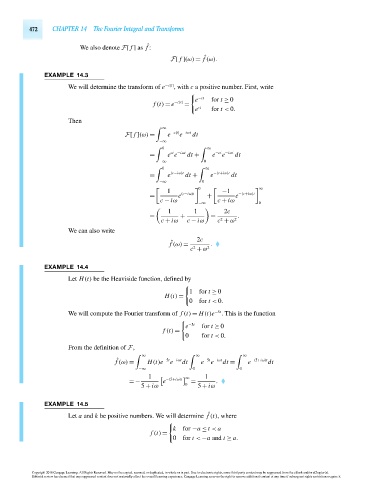Page 492 - Advanced_Engineering_Mathematics o'neil
P. 492
472 CHAPTER 14 The Fourier Integral and Transforms
ˆ
We also denote F[ f ] as f :
ˆ
F[ f ](ω) = f (ω).
EXAMPLE 14.3
We will determine the transform of e −c|t| , with c a positive number. First, write
e −ct for t ≥ 0
f (t) = e −c|t| =
e ct for t < 0.
Then
∞
e
F[ f ](ω) = e −c|t| −iωt dt
−∞
0 ∞
ct −iωt
e
= e e dt + e −ct −iωt dt
−∞ 0
0 ∞
= e (c−iω)t dt + e −(c+iω)t dt
−∞ 0
0 ∞
1 −1
= e (c−iω)t + e −(c+iω)t
c − iω c + iω
−∞ 0
1 1 2c
= + = .
c + iω c − iω c + ω 2
2
We can also write
2c
ˆ
f (ω) = .
2
c + ω 2
EXAMPLE 14.4
Let H(t) be the Heaviside function, defined by
1for t ≥ 0
H(t) =
0for t < 0.
We will compute the Fourier transform of f (t) = H(t)e −5t . This is the function
e −5t for t ≥ 0
f (t) =
0 for t < 0.
From the definition of F,
∞ ∞ ∞
e
e
ˆ
f (ω) = H(t)e −5t −iωt dt e −5t −iωt dt = e −(5+iω)t dt
−∞ 0 0
1 ∞ 1
=− e −(5+iω)t = .
5 + iω 0 5 + iω
EXAMPLE 14.5
ˆ
Let a and k be positive numbers. We will determine f (t), where
k for −a ≤ t < a
f (t) =
0 for t < −a and t ≥ a.
Copyright 2010 Cengage Learning. All Rights Reserved. May not be copied, scanned, or duplicated, in whole or in part. Due to electronic rights, some third party content may be suppressed from the eBook and/or eChapter(s).
Editorial review has deemed that any suppressed content does not materially affect the overall learning experience. Cengage Learning reserves the right to remove additional content at any time if subsequent rights restrictions require it.
October 14, 2010 16:43 THM/NEIL Page-472 27410_14_ch14_p465-504

